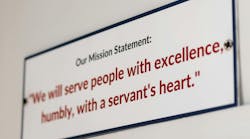Many sales training programs for the last several decades have focused on the wants, needs and desires of the customer as the focal point of any good sales presentation. The idea is that if you appeal to what the customer wants, needs and desires he will be more likely to purchase.
While this theory is certainly true insofar as appealing to the customer, it is not nearly as effective to lump all of those descriptors into a single category. And this is the big flaw in the idea in general. It lumps two completely different motivators into the same category.
Therefore, forget about trying to appeal to the customer’s wants, needs and desires, and instead focus your efforts on one of two similar yet completely separate motivators.
Establish the Need
It is a fair assumption that most customers will not buy any particular item or service unless there is an obvious need for it. To that end, we need to demonstrate to the customer a particular need of theirs that we are able to fulfill.
First of all, we must admit that each of us has many, many needs. Big needs and little needs. Most people have a lot of needs and they are well aware of them. And likewise, most people have a lot more needs that they are completely unaware of.
We must satisfy this issue with a two-pronged approach. First, we must demonstrate to the customer that they have a particular need. This will introduce an immediate level of tension in your customer’s life. I do not mean tension in such a way as to make your customers uncomfortable.
No, what tension in this situation means is that the customer has become acutely aware of a pressing need in their life right now. They become aware of the immediacy of this need through our skillful use of our presentation skills to show them exactly what and why there is a need at all.
Now, simply saying something like, “I checked your antifreeze for you, and it is dirty, so you need to have it changed” is not a very good presentation skill. However, this is an area where a lot of technicians alienate the customer, for one of several possible reasons.
First of all, just telling someone that their car needs a particular part or service without any independent input from them is a clear method for keeping the customer out of the loop.
Obviously, we want the customer in the loop. Meaning, you want to always include the customer’s input in any situation where you are trying to determine what parts or services a particular vehicle needs. This is extremely important. Remember, we are ultimately servicing customers, not vehicles. The cars didn’t drive themselves to your shop, right?
To simply tell a customer a list of things his car may need without any input, the car owner can see this as rude and insulting. It tends to make the customer feel that we have arrived at this prognosis about the vehicle without any consideration for them.
Joint Effort
The most effective method is to always get the customer involved in the process of determining that something may need to be serviced on their vehicle. Let the customer feel like they are the ultimate reason something either does or does not need to be serviced on their vehicle. If a particular item does not need servicing, give credit to the customer.
For instance, if the air filter is clean, don’t simply say something like, “The air filter is still clean, so there is no need to replace it today.” That leaves the customer out, doesn’t it?
Try this instead: “I can see that you have kept a clean air filter in place, so there is no need for you to purchase a new one today.”
Give the credit for the clean air filter to the customer, not to the car or the actual filter. It makes a big difference in the customer’s mind.
Likewise, if there are recommendations that you are making to your customers, make sure and get them involved also. How to do this? Well, it’s actually quite simple. There are really only three things you need to know to establish if a customer’s vehicle has any particular need for a service or part.
First, what is the car manufacturer’s recommended mileage interval? (If you are not using the factory-recommended mileages, you are asking for trouble!). For instance, maybe the car you are working on is a typical Chrysler product that is a few years old and recommends a coolant flush/service at 48,000 miles. Simply tell that information to your customer. Part one: handled.
Second, make reference to the vehicle’s actual accumulated mileage. That is, the current mileage on the vehicle right now. Again, verbalize this to your customer. Just because they told you the mileage five minutes ago when you asked them how many miles were on it during the greeting doesn’t mean they are still thinking about it at this moment in time.
And lastly, this is where you get the customer involved. Ask the customer “How long has it been since this was done?” Even if you know exactly how long it has been without having to ask the customer is no reason to not ask the customer anyway. By asking the question to the customer, he will give you a response that will allow you to continue with your presentation for that particular item.
This serves to make the customer feel that they are responsible for any servicing that needs to be done on their vehicle. It is far more effective than you just telling them what you think their vehicle needs.
An example of this could be something like this:
“Sir, I also checked your antifreeze for you, and it is right up the full mark on the overflow container.
“Chrysler recommends that you have the entire cooling system flushed and refilled with new coolant at least once every 48,000 miles, and your vehicle currently has 65,200 miles on it.
“How long has it been since you had the cooling system on your car flushed out?”
Now, the customer’s response to this question will tell you exactly whether the service needs to be done or not. No guessing or opinions involved. You will either be able to say, “Well, you need to get your cooling system serviced” and then continue on with your presentation, or you may have to say,
“OK, then you should be all set for now.”
The real beauty of this technique is that it will dramatically lower the incidence of the customers getting aggravated or angry with you for making recommendations.
Why do they get angry with us? Because we make recommendations without any input from them! Makes them feel unimportant to us. Getting the customer involved in the process of determining the need is the best method for getting them to let you continue on with your presentation.
Establish the Want
Getting the customer to acknowledge that they need some kind of service or part on their vehicle is important, but it in no way means that the customer wants to have the service done.
Remember, what any customer needs and wants are two completely separate things. Now that we know that they know they need something, let’s try to get them to want it. If you only remember one thing, let it be this: Unless they want it, they will not buy it. Needing it is not enough.
To create the desire to want something in anybody, you only need to concentrate on two things: Features and benefits. Let’s talk about features first. A feature is what the service or part is all about. Simply stated, you are just describing what the service is all about.
This does not man telling them any benefits at this point. Just tell them about the service. As an example, the features of a cooling system presentation may go something like this: “We do the cooling system flush service here, and it is a complete, 100%-percent fluid flush of the entire system. This will remove the scale and corrosion that is built up in the system, and we then refill it with new high-performance anti-freeze/coolant.”
That’s the features, now tell them the benefits. Make sure that you tell them the benefits to the customer, and not the car!
Example: “This service will help prevent overheating, and the special lubricants in the new coolant will help prevent premature water pump failure, giving you the peace-of-mind for the next 48,000 miles.”
These things are pretty generally desirable from just about any lube-shop customer, so you can’t go far wrong using them as value-builders. If you perform the “need” procedures and the “want” procedures effectively, your presentations will become much more effective.
Winning presentations are simple if you just train yourself to consistently follow procedures that produce results. Thanks for reading, and I’ll be here again next month for some more great tips for you.
And remember: Make it happen!





